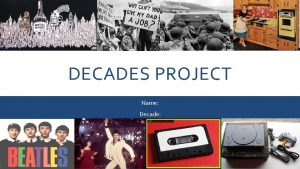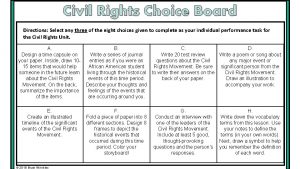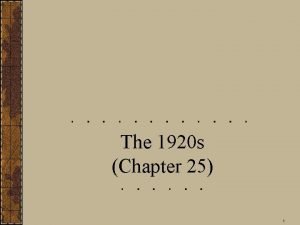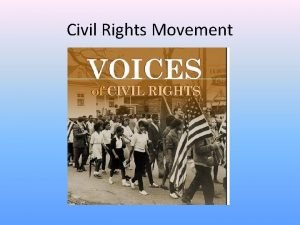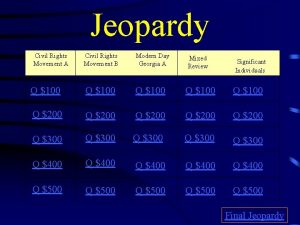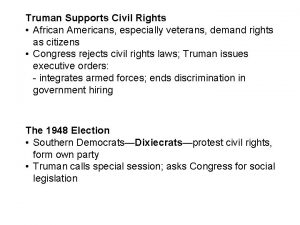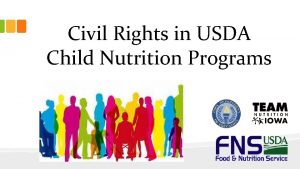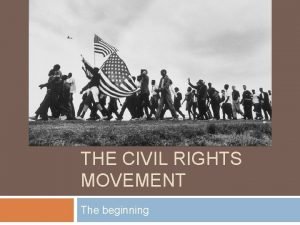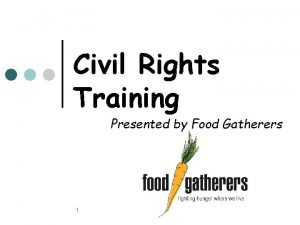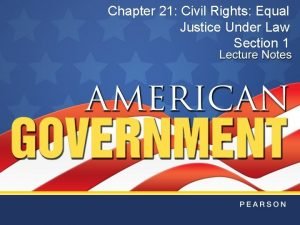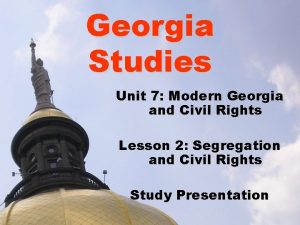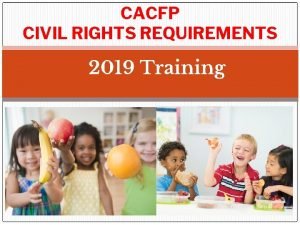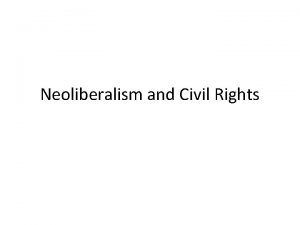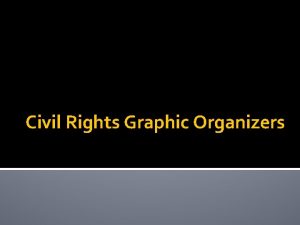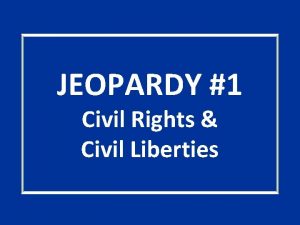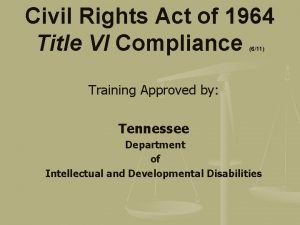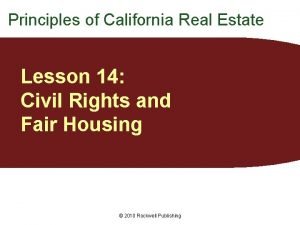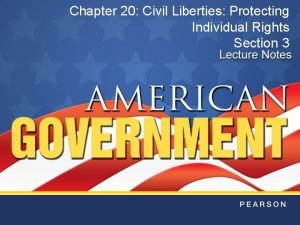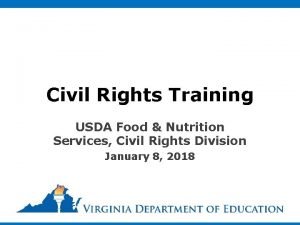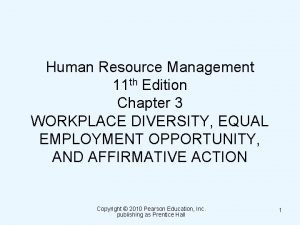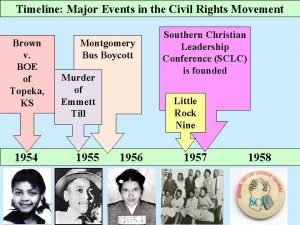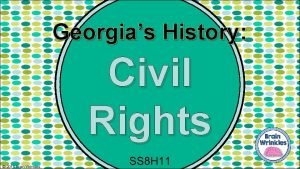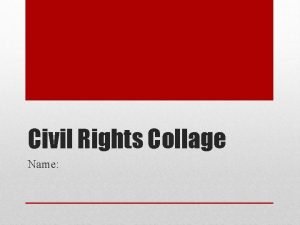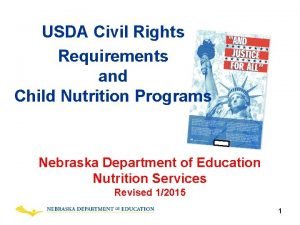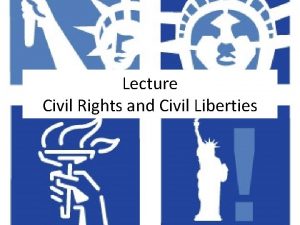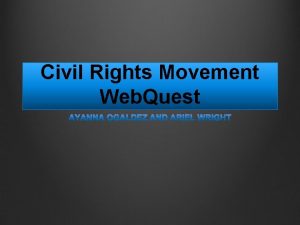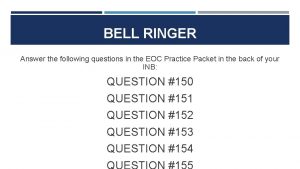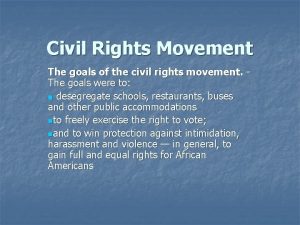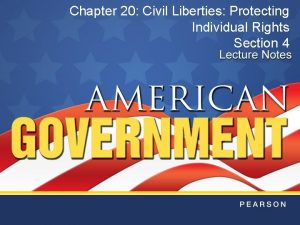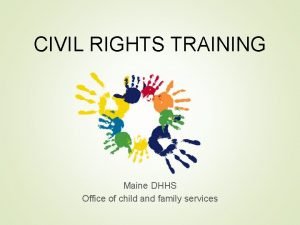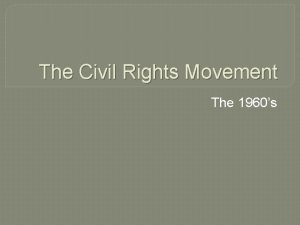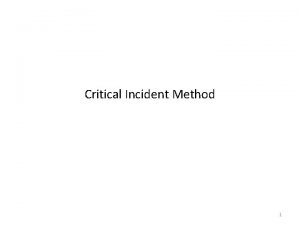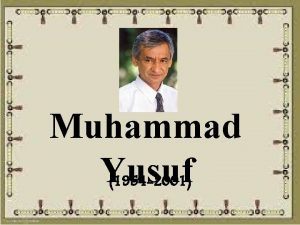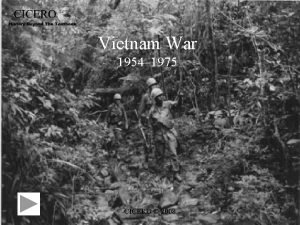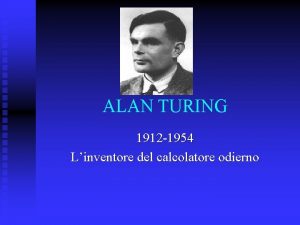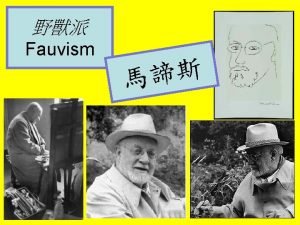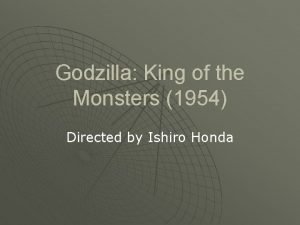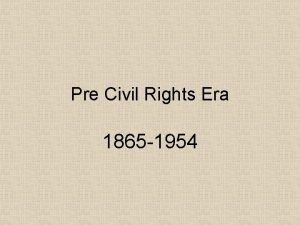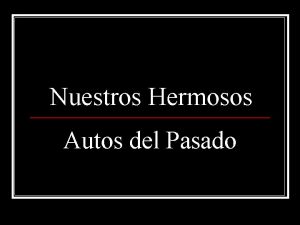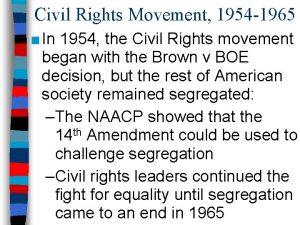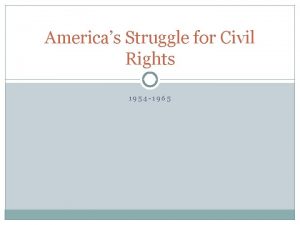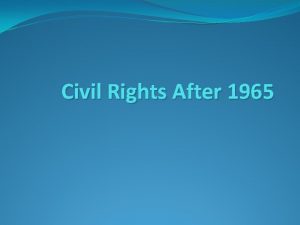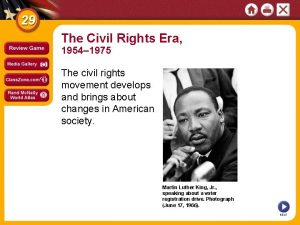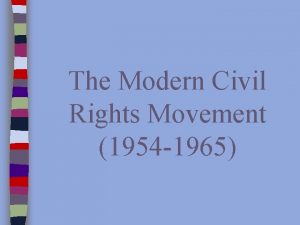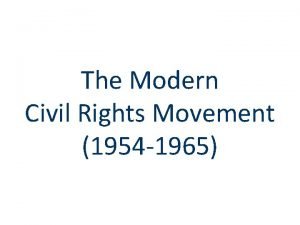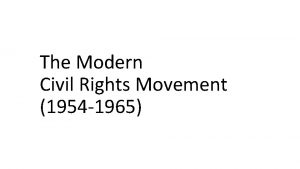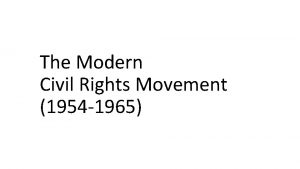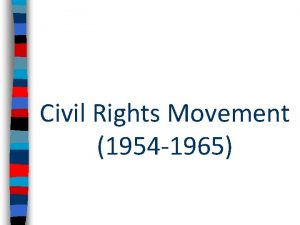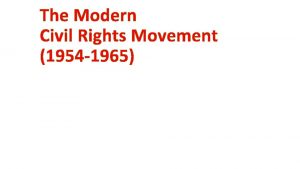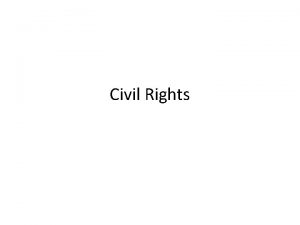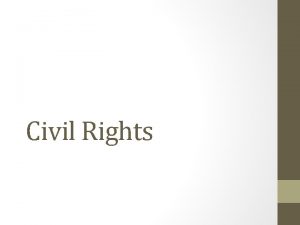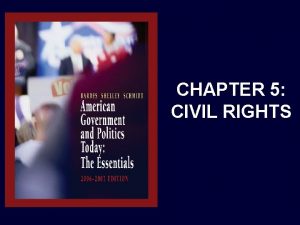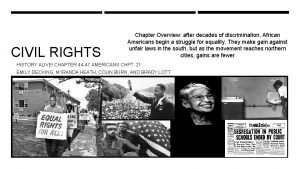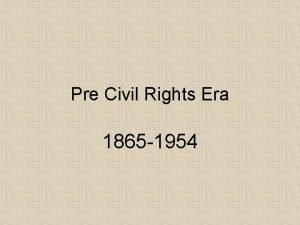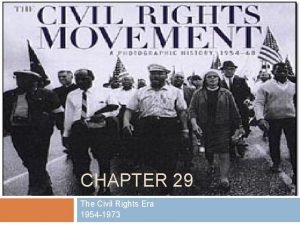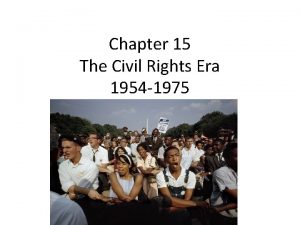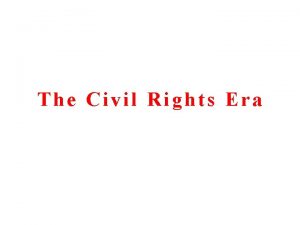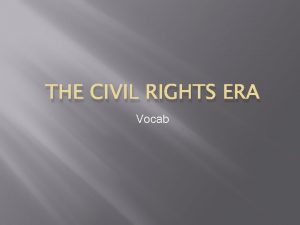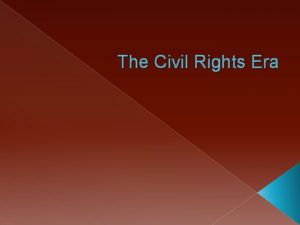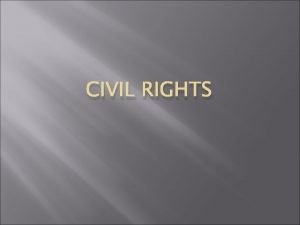Civil Rights Era 1954 1965 After decades of



























































- Slides: 59

Civil Rights Era (1954 – 1965) After decades of discrimination, African Americans (including some Whites) begin a struggle for equality. They make gains against unfair laws in the South.


What caused the Civil Rights Movement…. . 1. Resurgence of Racial Terrorism: n The KKK (Ku Klux Klan) came back into existence and they: n Burned crosses and murdered blacks seeking Civil Rights 2. Plessy v. Ferguson ruling A. K. A. Jim Crow Laws 3. World War II: n Blacks had experienced better job opportunities during WWII. Many WWII veterans had fought racist Germans and they now wanted to resist racist America.

What caused the Civil Rights Movement…. . n n NAACP began to challenge segregation laws. African Americans had more Political Power Push for desegregation Brown v. Board of Education (1954) ruling

School Desegregation and Supreme Court Victories n 1896 - Plessy v. Ferguson case made it constitutional to allow separate but equal schools n n In other words, Black and white students could not go to the same school 1954 - Brown v. Board of Education of Topeka (Kansas) case overturned 1896 Plessy v. Ferguson ruling unconstitutional (illegal). n In other words, “separate but equal” or “separate educational facilities” is against the law.

Brown v. Board of Education & The NAACP n Synopsis of Case: Eight year old Linda Brown charged the Board of Education of Topeka, Kansas with violating her rights by denying her admission to an all white elementary school that was four blocks away from her house. The all black elementary school was 21 blocks away from her house. § How did Linda Brown know to take this to court? There were “case hunters” in the NAACP who went around the South to find cases to bring to the Justice System. It was a hope these cases would make social change. § At this time, the NAACP was known for providing legal services and advice to Blacks. § Great Site for more learning: http: //www. nps. gov/history/nr/travel/civilrights/ka 1. htm § Also, See page 914 of the America’s Textbook

Thurgood Marshall n n n Lawyer for the NAACP First African American on the United States Supreme Court He is the lawyer who argued in the Brown v. Board of Education of Topeka Case. n Thurgood Marshall was NOT in support of having segregated schools.

Civil Rights What does it mean? Civil rights are the protections and privileges of personal power given to all citizens by law.


Segregation n n What does it mean? Being “separated” n For instance, Blacks (whether rich, middle class, or poor) could only find housing in allblack neighborhoods. n Page 907 of America’s Textbook

Segregation n De facto segregation – segregation by custom and tradition n De jure segregation – legalized segregation


Jim Crow Laws n What does it mean? n n Because of Jim Crow laws there were separate: n n n It was laws aimed at separating the races (Black and White) Schools, waiting rooms, restrooms, water fountains, streetcars railroad coaches, elevators, witness stands in courts. Facilities for Blacks were always inferior to those of whites. More about Jim Crow: http: //www. jimcrowhist ory. org/history/creatin g 2. htm

De-segregation n What does this term mean based on the Civil Rights Era? n n Integrating with the White race Ending Segregation Going to facilities with Whites without being discriminated against Going to school with Whites

Once the civil rights movement bein Montgomery bus boycott n African American churches hosted forums and planning meetings n Sit-ins occurred across the south n The Freedom Riders began to go South n Protests within segregated states n

Examples of Separate But Equal Facilities (i. e. facilities in support of Jim Crow Laws)

The Result of the Brown v. Board of Education of Topeka Case Led to White Resistance against Blacks…… n White resistance occurred because Whites did not want integration in any type of facility with African Americans.

White Resistance Against Blacks n Emmet Till n A 14 year old African American boy from Chicago was murdered by white men in Mississippi who took offense at the way he spoke to a white women. Emmet Till was visiting the South with his family for the summer. n In the Chicago, it was acceptable to speak to white women…this was not acceptable in the South. n The pictures to the right (above) shows how he looked when he was found. n His mother (Mamie Till) had a open casket funeral to show America what the racist South had done to her 14 year old son.

Emmet Till…. . n Just months after Emmett Till's murder, Look magazine published "The Shocking Story of Approved Killing in Mississippi, " in which Roy Bryant and J. W. Milam confessed to the crime. n Learn more about the Emmet Till Case and the murderers confession at: http: //www. pbs. org/wgbh/am ex/till/

Find out where the Emmet Till case stand in the Present time at…. . n http: //www. emmetttillstory. com/

White Resistance Against Blacks n “The Little Rock Nine”: n When the Supreme Court rule in the Brown v. Board case that separate but equal facilities unconstitutional, Eight black teenagers tried to attend Central High School (a white high school) in Little Rock, Arkansas. n The teenagers goal was to integrate the school. n The ninth teenager was surrounded by whites and escaped the white mobs with the help of a sympathetic white woman

White Resistance Against Blacks n “The Little Rock Nine”: n While attending Central High School the teenagers experienced racism and hate. n They were taught in a classroom separate from the white students. n They ate lunch without other students. n They had to leave school early before other students were dismissed to break away from racial hate and fights. n At one point, many parents dis -enrolled their students from Central High, which caused the school to close.

The Little Rock Nine….

Find our what the Little Rock Nine are doing now…. http: //www. centralhigh 57. org/The_Little_Ro ck_Nine. html n http: //www. nps. gov/history/nr/travel/civilrigh ts/ak 1. htm n

White Resistance Against Blacks n According to my mom who grew up in Mississippi: n “Many white schools would close down and relocate to areas that Blacks could not commute to. Other white schools would close and become private schools because they knew black people could not afford to pay for a private education. White schools in the South did want to experience what Central High School in Little Rock, Arkansas was experiencing.

President Eisenhower Response to White Resistance to Blacks n President Dwight Eisenhower disapproved of racial segregation…. He believed that “race relations would improve only if desegregation started locally”. n Due to this, Eisenhower sent National Guard Troops to Little Rock, Arkansas to protect the nine black students at the white high school (Central High), and sent the troops to control the angry crowds as well.

Whites Resistance Against Blacks n The Murder of Four Girls n On the early Sunday morning of September 15, 1963, Ku Klux Klan member, Robert Edward Chambliss stood a few blocks away from the Sixteenth Street Baptist Church in Birmingham, Alabama. On this morning, five girls were changing into their choir robes in the church basement. At 10: 19 a. m. , a bomb exploded, killing four of the girls and injuring twenty people. The four girls who died were eleven-year old Denise Mc. Nair, and fourteen year olds Addie Mae Collins, Carole Robertson (right), and Cynthia Wesley. n For more detail about this incident: http: //www. nps. gov/history/nr/travel/civ ilrights/al 11. htm

White Resistance against Blacks n De facto segregation that exists by custom and practice n n For instance: Charging higher rates and costs for Blacks on the same item another person can buy at lesser value. Also, police brutality, high unemployment rates in urban areas, and run down schools and communities in Black communities. n De jure segregation – by law n For instance: Jim Crow Laws or even the Plessey v. Ferguson ruling of “Separate but equal”

Blacks resisted Jim Crow laws and racial violence through…


Black Resistance to Jim Crow Laws n Montgomery Bus Boycott: n Jo Ann Robinson wrote a letter to the Mayor of Montgomery, Alabama asking that bus drivers no longer be allowed to force riders in the “colored” section of the bus to accommodate white bus riders. n The Mayor Refused!

Black Resistance to Jim Crow Laws n Rosa Parks: n n A Black seamstress add a NAACP Officer who took a seat in the front row of the “colored section” of a Montgomery bus. As the bus filled up, the driver ordered Parks and three others Black Passengers to empty the row so the white passengers could sit down without having to sit near a Black person. n n Parks refused to move and was sent to jail. This incident led to a Citywide bus boycott and brought Martin Luther King to prominence.

Black Resistance from two different stand points (views) n Martin Luther King n Believed in civil disobedience / non-violent (peaceful) response/ resistance to the Civil Rights Movement n n n In other words: don’t fight back even if you are spitted on. He adopted the beliefs of Mohandas Gandhi (the leader who helped India throw off British rule without using violence). He was an ordained Baptist minister n Malcolm Little (X) n n He blamed poverty and the social inferiority of Black people on Whites. He advocated armed resistance (violence) and self defense to white oppression He studied the teachings of Elijah Muhammad (the head of the Nation of Islam or Black Muslims). He considered the name Malcolm Little a slave name so he changed his name to Malcolm X.

Picture of…. . n Martin Luther King n Malcolm X

Resistance to Jim Crow Laws n The Creation of Grassroots Organizations: n n Grassroots organizations were headed by ministers and Civil Rights Leaders: For instance: n n n Southern Christian Leadership Conference (SCLC)- purpose was to “carry on non violent crusades against the evils of second class citizens”: This organization organized protests and demonstrations to promote civil rights and voting rights for African Americans. Student Nonviolent Coordinating Committee (SNCC)- this consisted of college who viewed the pace of change as too slow. They challenged the system through protest …. many were expelled from school. The also coordinated Voter Registration in the South; one of which was Medgar Evers who was killed for his progressive efforts. Congress of Racial Equality (CORE): organized non violent protests and demonstrations, such as sit-ins and the freedom riders.

Resistance to Jim Crow Laws n Freedom Riders: n Were CORE and SNCC volunteers usually from the North (both Black and White): n n These riders hoped to call attention to the South’s refusal to abandon segregation. These riders hoped this would pressure government to enforce the Supreme Court’s desegregation ruling from the 1954 Brown v. Board of Education case. Unfortunately, the never made it South because their bus got burned when they were headed to the South


Resistance to Jim Crow Laws n Sit-in movement (nonviolent demonstration based on the views of Martin Luther King, Jr. and many grassroots organizations): n Non-violent African Americans sat at down at segregated lunch counters and refused to leave until they were served. n n Most popular: Greensboro, North Carolina On the other hand, Whites who participated with Blacks in sit ins experienced humiliation and intimidation from other whites.

Resistance to Jim Crow Laws n March on Washington n A. Philip Randolph, a civil rights leader and union organizer, helped organize the march on Washington.

Resistance to Jim Crow Laws n March to Washington: n n Many people (250, 000 people, which included about 75, 000 whites) marched on Washington to urge government to revise / add to the Civil Rights Bill. There were several speakers at the march on Washington, one of which was Martin Luther King, Jr.

Resistance to Jim Crow Laws n Freedom Singing n The Freedom Singers (both Black and White) were different singers and chorus that traveled throughout the country providing inspiration and raising funds for the Civil Rights movement.

Resistance to Jim Crow Laws n NAACP Organizing: n NAACP organizers (both Black and White) went to local areas (in the South) to investigate the murders of Blacks. They wanted to investigate the murders because local police in those areas generally dismissed such killings as “accidents”. n n Medgar Evers was an organizer in the South…. he was assassinated by whites who opposed his investigative works. Others came up MISSING (like the one’s to the right)!

We will view a scene from Mississippi Burning in class regarding the three males on the previous slide…

Resistance to Jim Crow Laws n Freedom Summer in Mississippi (1964) n Volunteers, both black and white, brought a sense of hope and support to Black Mississippians through: n n Freedom Schools for Blacks (to educate) Freedom Clinics (health facilities') Freedom theatres (for entertainment) This allowed those in Mississippi to develop a sense of pride and self worth.

Martin Luther King letter from a Birmingham Jail…… n Letter from Birmingham Jail — April 16, 1963 n While jailed for leading anti-segregation protests in Birmingham, King wrote this letter arguing that individuals have the moral duty to disobey unjust laws. n “We know through painful experience that freedom is never voluntarily given by the oppressor; it must be demanded by the oppressed. Frankly I have never yet engaged in a direct action movement that was "well timed, " according to the timetable of those who have not suffered unduly from the disease of segregation. For years now I have heard the word "Wait!" It rings in the ear of every Negro with a piercing familiarity. This "wait" has almost always meant "never. " We must come to see with the distinguished jurist of yesterday that "justice too long delayed is justice denied. " ……. n See the rest of the letter at: http: //www. stanford. edu/group/King/popular_requests/frequentdocs/birmingham. pdf

Martin Luther King, Jr. I Have a Dream Speech…. . n I have a dream that one day this nation will rise up and live out the true meaning of its creed: “We hold these truths to be self-evident: that all men are created equal. ” I have a dream that one day on the red hills of Georgia the sons of former slaves and the sons of former slaveowners will be able to sit down together at a table of brotherhood. I have a dream that one day even the state of Mississippi, a desert state, sweltering with the heat of injustice and oppression, will be transformed into an oasis of freedom and justice. I have a dream that my four children will one day live in a nation where they will not be judged by the color of their skin but by the content of their character. I have a dream today. n See the rest of the speech at: http: //www. stanford. edu/group/King/publications/speeches/ad dress_at_march_on_washington. pdf

Compare and Contrast Various Ideas of each… Martin Luther Declaration of Kings March Independence on Washington Speech King Spoke for his desire for Blacks and Whites, among others, to be considered Equals in all aspects of society. Declaration of Independence is an assertion of the independence from the King. The Declaration of Sentiments at the Seneca Falls Convention (Organized by Elizabeth Cady Stanton and Lucretia Mott) Gettysburg Address by Abraham Lincoln This Declaration demanded that the rights of women must be acknowledged and respected by society. It was stated that all men and women are created equal. It was also stated that it is the right of those who suffer from discrimination to assist upon to a new laws so that all people can receive the life, liberty, and the pursuit of happiness. In this Address, Lincoln used the principles of human equality stated in the Declaration of Independence to redefine the Civil War as a struggle for "a new birth of freedom" that would bring true equality to all of its citizens, and that would also create a unified nation.

Resistance against Blacks who were against Jim Crow Laws and wanted Equality n n n Blacks were sent to jail for protesting Blacks were sprayed with fire engine high pressure water hoses Police dogs were used to break up demonstrations

There were challenges' and changes in the Civil Rights Movement…. Disagreements among Civil Rights groups and the rise of black nationalism created a violent period in the fight for Civil Rights

Black Nationalism? n What does this mean? n Black Power – According to Stokely Carmichael , it is “a call for black people to begin to define their own goals… and to lead their own organizations without the aid of Whites. ” § This meant that whites would not be able to join Blacks in their fight for equality. § More understanding…go to: http: //en. wikipedia. org/wiki/Black_Panther_Party

Black Power led to the Black Panthers n Black Panthers: n A political party founded in Oakland, California in October 1966 by Huey Newton and Bobby Seale n Black Panthers advocated self -sufficiency in African American Communities (i. e. Buy from Black businesses and support each other business); as well as for full employment and decent housing of Blacks. n They wanted African Americans to be exempt from the Vietnam war.

Black Panther Party…

The Civil Rights Era was not just about racial violence and inequality…. .

A middle class nation in the United States was emerging during the Civil Rights Era. . . n Despite resistance to Civil Rights in the 1950’s, the United States was becoming a middle class nation. n National prosperity offered more Americans material comfort and economic security. § The GI Bill for WWII veterans allowed the veterans to go to college, get homes in suburbs, and live in the suburbs. n Labor relations (between employer and employee) was more peaceful: § The United Auto Workers (UAW) emerged § General Motors led the way (was the model) for others companies to began to offer health insurance, pension plans, and guaranteed wage (pay) increases.

Middle Class Americans during the Civil Rights Era…. n Looked to the media for advice on matters ranging from how to celebrate a Holiday to how to raise a child. n Lived in suburbs (usually white families) n Many families had different beliefs and customs in the suburbs but they frequently developed the same norms (ways of doing things).

There were achievements of the Civil Rights Era that affects us today in some type of way…

President Lyndon Johnson signs the Civil Rights Bill of 1964…

Some Accomplishments of the Civil Rights Movement n n End of legalized segregation Constitutional and legal protection of civil and voting rights of all people Increased pride in racial identity More African American Voters n More African American elected officials n n i. e. Shirley Chisholm – first African American Women in the U. S. House of Representatives More African American college and high school graduates

To learn more view…… n n n The Montgomery Bus Boycott: http: //www. watson. org/~lisa/blackhistory/civilrights-55 -65/ Civil Rights Movement: http: //www. cnn. com/EVENTS/1997/mlk/links. html Civil Rights Movement: http: //pbskids. org/wayback/civilrights/ Malcolm X: http: //www. cmgww. com/historic/malcolm/about/photos. htm Wilkipedia: http: //en. wikipedia. org/wiki/American_Civil_Rights_Movement _(1955 -1968)
 Civil rights and civil liberties webquest
Civil rights and civil liberties webquest After me after me after me
After me after me after me After me after me after me
After me after me after me Last decades art
Last decades art One step forward two decades back
One step forward two decades back Decades project examples
Decades project examples Civil rights choice board
Civil rights choice board Chapter 14 postwar prosperity and civil rights
Chapter 14 postwar prosperity and civil rights Civil rights movment
Civil rights movment Civil rights movement jeopardy
Civil rights movement jeopardy Truman supports civil rights
Truman supports civil rights Civil rights in child nutrition programs
Civil rights in child nutrition programs The civil rights movement
The civil rights movement Civil rights training quiz answers
Civil rights training quiz answers Mother of the modern day civil rights movement
Mother of the modern day civil rights movement Civil rights movement vocabulary
Civil rights movement vocabulary Chapter 21 civil rights equal justice under law
Chapter 21 civil rights equal justice under law What did sncc accomplish and how
What did sncc accomplish and how Unit 7 modern ga and civil rights
Unit 7 modern ga and civil rights Cacfp civil rights
Cacfp civil rights Characteristics of civil rights
Characteristics of civil rights Civil rights graphic organizer
Civil rights graphic organizer Civil rights jeopardy
Civil rights jeopardy Title vi of the civil rights act of 1964
Title vi of the civil rights act of 1964 Levittown apush
Levittown apush Unruh civil rights act real estate
Unruh civil rights act real estate Chapter 20 civil liberties protecting individual rights
Chapter 20 civil liberties protecting individual rights Chapter 20 civil liberties protecting individual rights
Chapter 20 civil liberties protecting individual rights Usda civil rights training
Usda civil rights training Title vii of the civil rights act
Title vii of the civil rights act Civil rights timeline of events
Civil rights timeline of events Civil rights cloze notes 1
Civil rights cloze notes 1 Civil rights leaders collage
Civil rights leaders collage Civil rights movement essential questions
Civil rights movement essential questions Civil rights in child nutrition programs
Civil rights in child nutrition programs Right to die
Right to die Civil rights movement webquest
Civil rights movement webquest Civil rights bell ringers
Civil rights bell ringers Civil rights movement goal
Civil rights movement goal Chapter 20 civil liberties protecting individual rights
Chapter 20 civil liberties protecting individual rights Civil rights training certificate
Civil rights training certificate Title vii of the civil rights act
Title vii of the civil rights act Brain wrinkles social studies answer key
Brain wrinkles social studies answer key Civil rights sitins
Civil rights sitins Flanagan 1954
Flanagan 1954 1954
1954 Ibm 1954
Ibm 1954 Frida kahlo 1907 a 1954
Frida kahlo 1907 a 1954 Muhammad yusuf sherlari maylida
Muhammad yusuf sherlari maylida 1975-1954
1975-1954 1954
1954 Lydia delectorskaya henri matisse
Lydia delectorskaya henri matisse 1970-1954
1970-1954 Ron hubbard 1954
Ron hubbard 1954 Godzilla king of the monsters 1954
Godzilla king of the monsters 1954 Başhemşire nasıl olunur
Başhemşire nasıl olunur Hurricane hazel track
Hurricane hazel track Ruby bridges how old is she
Ruby bridges how old is she 1954-1865
1954-1865 1949 cadillac series 62 4 door
1949 cadillac series 62 4 door





